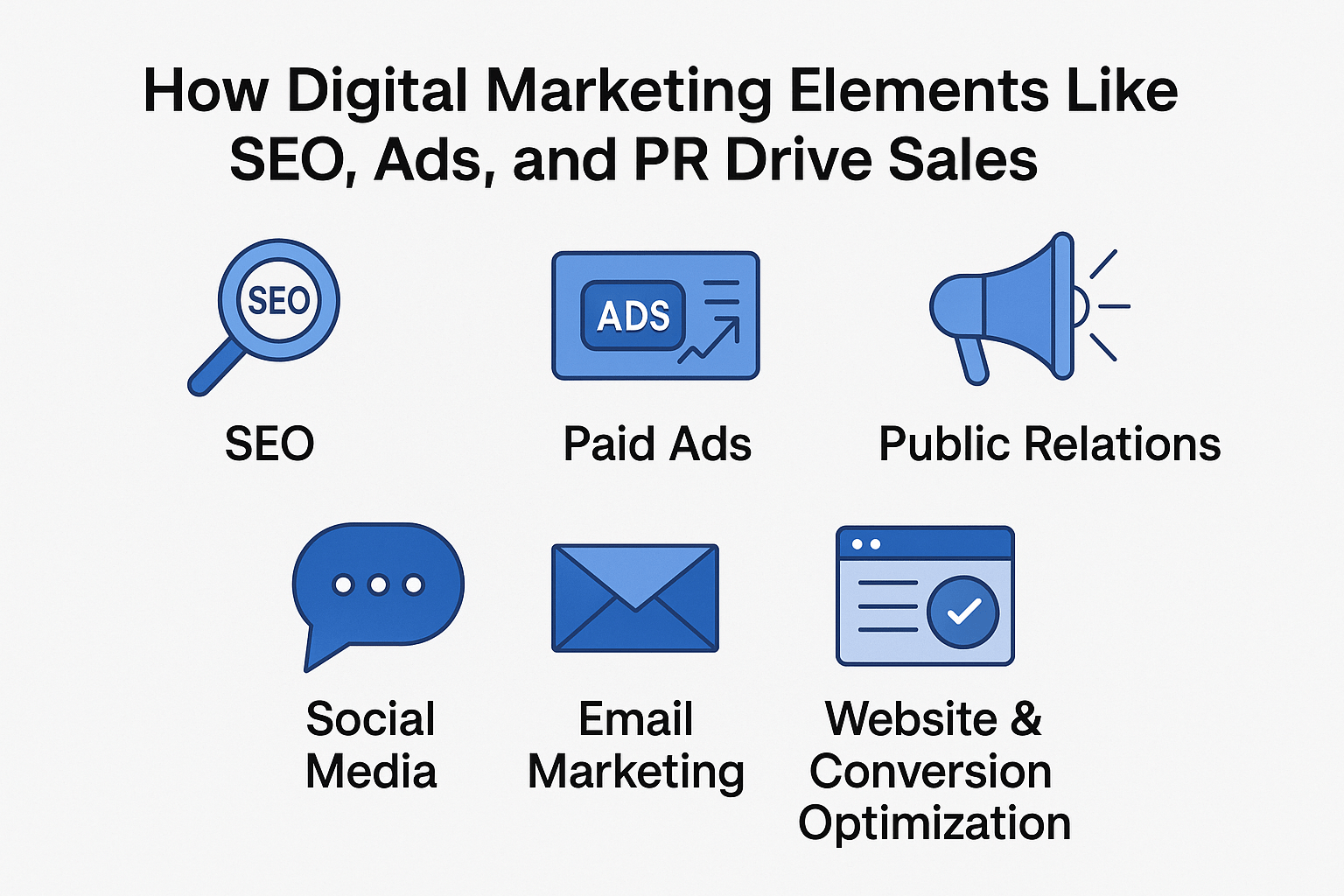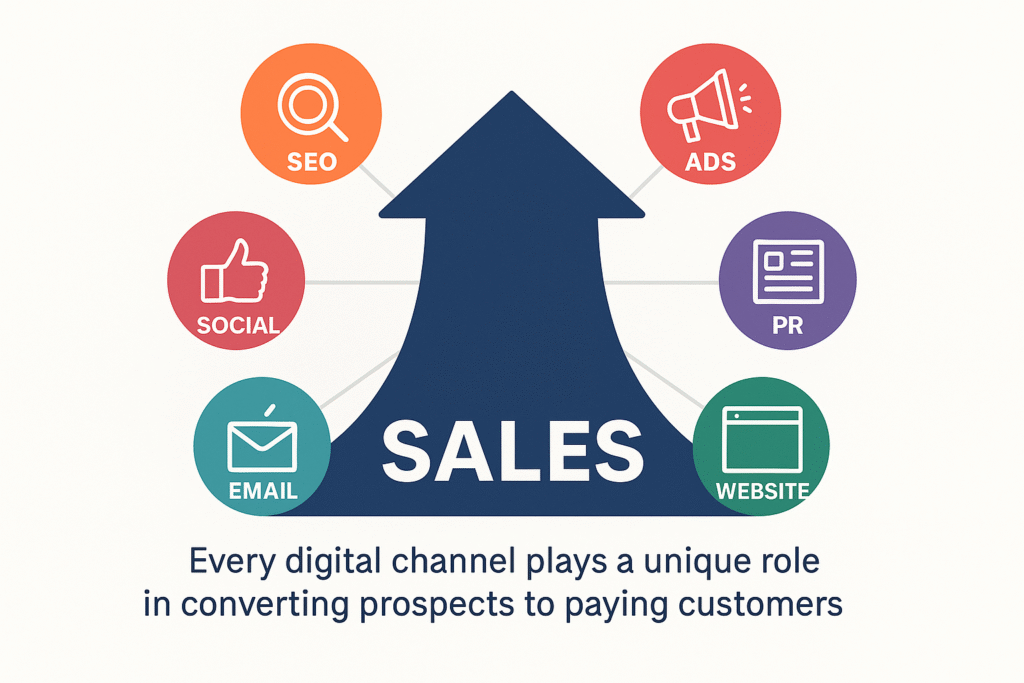
In today’s digital economy, sales don’t happen by chance, they happen by strategy. Whether you’re running an eCommerce brand, SaaS startup, or service-based business, your customers are interacting with multiple marketing touchpoints before they convert.
You might ask:
“Do I need SEO and PR and ads and email marketing?”
Yes. Because each element plays a unique role in moving your audience from awareness to action.
In this blog, we break down how every major digital marketing component contributes to driving sales and why a well-rounded strategy is non-negotiable.
1. SEO – The Silent Sales Engine
What is SEO?
Search Engine Optimization helps your website appear when people search for relevant keywords—bringing in organic traffic with high buying intent.
How it impacts sales:
- Captures customers already searching for your product
- Brings in long-term, cost-effective leads
- Builds trust by ranking high on Google
Example:
Ranking for “best sustainable backpacks” gets your product in front of someone already ready to buy.
Tools to Use: Ahrefs, Ubersuggest, Yoast, SurferSEO
💸 2. Paid Ads – The Sales Accelerator
What are Paid Ads?
Google Ads, Instagram promotions, YouTube pre-rolls—ads that get your product in front of targeted users fast.
How it impacts sales:
- Targets people ready to take action
- Drives immediate traffic to landing pages
- Supports campaign launches, offers, and product drops
Example:
Run a Facebook ad with a 20% launch discount → New customer converts in one click.
Tools to Use: Google Ads Manager, Meta Ads, AdCreative.ai
3. Public Relations (PR) – The Trust Multiplier
What is PR?
Getting featured in media outlets, magazines, blogs, or podcasts to build your reputation.
How it impacts sales:
- Adds third-party validation
- Influences investor and buyer confidence
- Boosts brand credibility for high-ticket offers
Example:
You’re featured in a Times of India story → A curious reader Googles your brand → Finds your site → Buys.
Tools to Use: Digi eRelease, PR Newswire, HARO
4. Social Media – The Engagement Engine
What is Social Media Marketing?
Organic content on platforms like Instagram, LinkedIn, or X (Twitter) that engages, educates, and entertains.
How it impacts sales:
- Builds relationships with future buyers
- Creates shareable moments and community buzz
- Drives traffic to product pages via bio links, stories, and DMs
Example:
A viral reel showcasing your product leads to 3x website traffic and a spike in sales.
Tools to Use: Canva, Buffer, Hootsuite, LinkedIn, Instagram
5. Email Marketing – The Revenue Retention Tool
What is Email Marketing?
Sending newsletters, campaigns, and automation sequences to convert leads and keep customers engaged.
How it impacts sales:
- Converts warm leads over time
- Increases repeat purchases
- Recovers abandoned carts and promotes limited-time deals
Example:
A 3-email welcome series boosts your first-order conversion rate by 22%.
Tools to Use: Mailchimp, ConvertKit, Klaviyo
6. Website & Conversion Optimization – The Final Touchpoint
What is Conversion Optimization?
Improving the layout, messaging, speed, and UX of your website or landing pages.
How it impacts sales:
- Increases conversion rate from traffic you’re already getting
- Reduces bounce rate
- Makes your sales funnel efficient
Example:
Changing your CTA from “Submit” to “Get My Free Trial” increases conversions by 15%.
Tools to Use: Hotjar, Google Optimize, Webflow, Unbounce
7. Analytics – The Sales Feedback Loop
What is Marketing Analytics?
The process of measuring performance to know what’s working—and what isn’t.
How it impacts sales:
- Tells you where sales are really coming from
- Helps you double down on high-ROI channels
- Allows smarter budget decisions
Tools to Use: GA4, Looker Studio, HubSpot CRM
The Big Picture: Why You Need Every Piece
Think of your digital marketing strategy like a puzzle, remove one piece, and the whole picture falls apart. Here’s how they work together:
| Marketing Channel | Sales Role |
|---|---|
| SEO | Drives long-term, high-intent traffic |
| Ads | Captures ready-to-buy users fast |
| PR | Builds credibility and authority |
| Social Media | Nurtures engagement and awareness |
| Converts and retains customers | |
| Website | Final conversion point |
| Analytics | Optimizes performance and ROI |

You don’t need to be everywhere, but you do need the right things working together. A successful marketing strategy isn’t built on one magic tactic—it’s a system of connected actions that take someone from stranger to customer.
Want more sales? Start by asking:
“Is my SEO working? Am I retargeting? Are people engaging? Is my site converting?”
If you’re only doing one, you’re leaving money on the table.
If you align them all—you’re building a growth machine.
